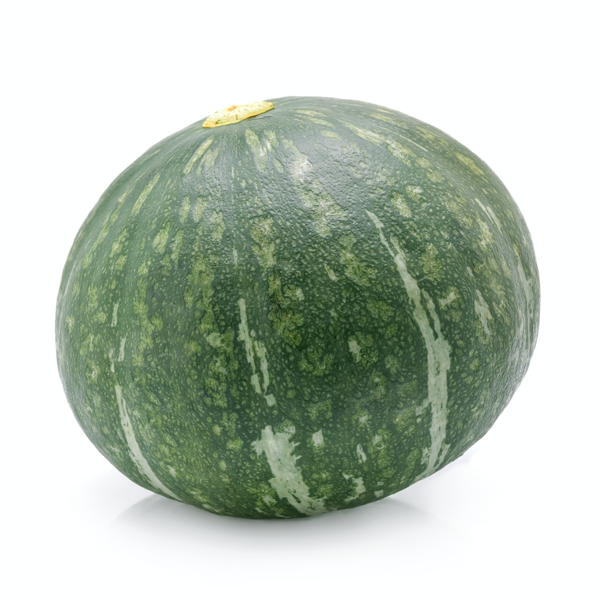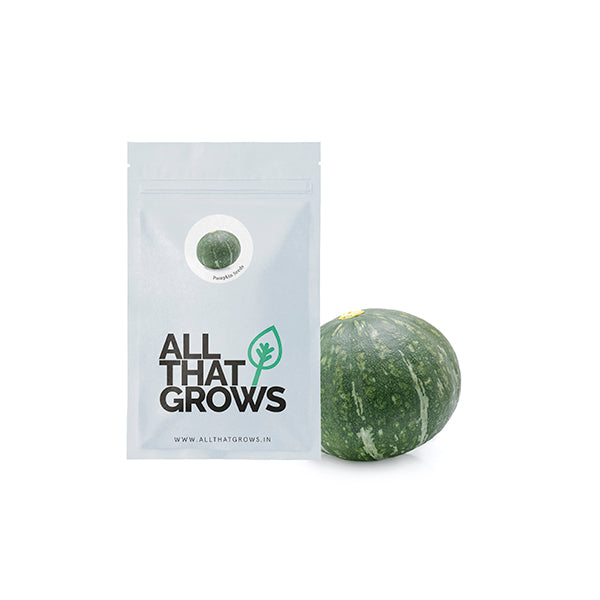



Pumpkin Seeds
Grow this with
Seed Type : Non-Hybrid, Open Pollinated and Non-GMO
Plants : Long veins, well branched
Sowing time : Summer as well as rainy season
Fruit: Flattish round with deep ridges
Fruit Skin : Shinning dark green in colour with yellowish spots/netting all over, flesh yellowish orange.
Fruit weight : 3-4 kgs
Specification : Very attractive fruits, very high yielding, high tolerance to heat and humid condition.
- SOWING
TIMESummer
& rainy season - Sowing
DistancePlant to plant - 1'
Line to line - 4' - Fruit
Weight3-4 kgs
- Fruit
ShapeFlattish round
- Days to
maturity70-75 days
- Details
- How to sow
- Reviews
Unlike the ones found in the west with an orange skin and associated mostly with Halloween to be carved into Jack-o-Lanterns, in India pumpkins usually have a green skin. A part of the Cucurbitaceae family of plants just like cucumbers, squash and cantaloupes, pumpkins are widely cultivated and consumed all over the world. Though not everyone's favourite veggie, they are extremely healthy to eat1! Wait till you know of the nutritional value it carries. Pumpkins are an excellent source of Vitamin A, E, C, iron, folate, dietary fiber and antioxidants. Its consumption can greatly help you with lowering the risk of heart disease, diabetes, and breast cancer, while fighting fatigue, boosting the immune system, maintaining optimum weight, and improving vision and digestion. A water-rich vegetable, pumpkins will keep your feeling refreshed and hydrated sufficiently too.
Pumpkins are generally cooked after removing the seeds with spices. Also generously included in stews, soups, and even desserts. You can even steam, boil or bake it for a delicious savory dish.
Planting instructions
Sow seeds directly in the soil. Pumpkins are very sensitive to cold. Make sure the temperature is ideal before sowing.
Plant seeds in rows or “pumpkin hills” which are the size of small pitcher mounds. With hills, the land will warm more quickly and the seeds will sprout quickly. This also helps with drainage and pest control.
Prepare the hills in advance with old manure dug deep into the soil (12 to 15 inches).
Plant the seeds 1 inch deep (4 to 5 seeds per mound). Space mounds 4 to 8 feet apart.
Your plants should develop in less than a week and sprout within 5 to 10 days. When the plants are 2 to 3 inches tall, thin to 2 to 3 plants per hill by snipping off unwanted plants.
Growing Requirements
watering
Pumpkins are thirsty plants and need lot of water. Water one litre per week.
pests
The pumpkins that are attacked by pests may show the following signs - Plants show brown blotches or stunted and distorted growth, honeydew substance, white powdery spots on leaves, deformed (bumps) and discolored fruit and leaves, etc. Common pests that attack this crop are Squash bugs, Cucumber beetles, Aphids, Squash Vine Borer, Powdery Mildew, Anthracnose.
soil
They prefer very rich soil that is well-drained and not too soggy. The ideal pumpkin plant soil should have a pH range of 5.5-7.5.
spot
Choose a spot that receives plenty of sunlight to light shade
temperature
Seeds will germinate at 15°C (60°F), but they germinate best at 29-32°C (85°F-90°F)
how to harvest
A pumpkin ripens when its skin turns a rich, strong colour (orange for most varieties).
When you thumb the pumpkin, the rind will feel heavy and it will sound empty. Press your nail into the pumpkin’s skin; if it resists puncture, it is fully ripe.
Handle pumpkins very gently or they may bruise.
To harvest the pumpkin, cut the fruit off the vine carefully with a sharp knife or with the help of pruners, do not pull. Be certain not to trim too close to the pumpkin.
If you get a lot of vines and flowers but no pumpkins, you need more bees in your garden to pollinate the flowers.
Seeds can last for 6 years.

Customer Reviews
The productiveness of any seed we sell is subject to your local climatic conditions*, the sowing method you adopt, and your commitment to the planting process. We give no warranty, expressed or implied, and are in no way responsible for the produce.
Please note that all our seasonal recommendations/ sowing information is as per the local climatic conditions. *For more information on the optimum conditions required for growing seeds in your region, please contact us at, hello@allthatgrows.in or Whatsapp us at, +91 8544865077
Questions & Answers
Have a Question?
Be the first to ask a question about this.




Pumpkin Seeds
Seed Type : Non-Hybrid, Open Pollinated and Non-GMO
Plants : Long veins, well branched
Sowing time : Summer as well as rainy season
Fruit: Flattish round with deep ridges
Fruit Skin : Shinning dark green in colour with yellowish spots/netting all over, flesh yellowish orange.
Fruit weight : 3-4 kgs
Specification : Very attractive fruits, very high yielding, high tolerance to heat and humid condition.
Grow this with
Unlike the ones found in the west with an orange skin and associated mostly with Halloween to be carved into Jack-o-Lanterns, in India pumpkins usually have a green skin. A part of the Cucurbitaceae family of plants just like cucumbers, squash and cantaloupes, pumpkins are widely cultivated and consumed all over the world. Though not everyone's favourite veggie, they are extremely healthy to eat1! Wait till you know of the nutritional value it carries. Pumpkins are an excellent source of Vitamin A, E, C, iron, folate, dietary fiber and antioxidants. Its consumption can greatly help you with lowering the risk of heart disease, diabetes, and breast cancer, while fighting fatigue, boosting the immune system, maintaining optimum weight, and improving vision and digestion. A water-rich vegetable, pumpkins will keep your feeling refreshed and hydrated sufficiently too.
Pumpkins are generally cooked after removing the seeds with spices. Also generously included in stews, soups, and even desserts. You can even steam, boil or bake it for a delicious savory dish.
Seed Type : Non-Hybrid, Open Pollinated and Non-GMO
Plants : Long veins, well branched
Sowing time : Summer as well as rainy season
Fruit: Flattish round with deep ridges
Fruit Skin : Shinning dark green in colour with yellowish spots/netting all over, flesh yellowish orange.
Fruit weight : 3-4 kgs
Specification : Very attractive fruits, very high yielding, high tolerance to heat and humid condition.
- SOWING
TIMESummer
& rainy season - Sowing
DistancePlant to plant - 1'
Line to line - 4' - Fruit
Weight3-4 kgs
- Fruit
ShapeFlattish round
- Days to
maturity70-75 days
Planting instructions
Sow seeds directly in the soil. Pumpkins are very sensitive to cold. Make sure the temperature is ideal before sowing.
Plant seeds in rows or “pumpkin hills” which are the size of small pitcher mounds. With hills, the land will warm more quickly and the seeds will sprout quickly. This also helps with drainage and pest control.
Prepare the hills in advance with old manure dug deep into the soil (12 to 15 inches).
Plant the seeds 1 inch deep (4 to 5 seeds per mound). Space mounds 4 to 8 feet apart.
Your plants should develop in less than a week and sprout within 5 to 10 days. When the plants are 2 to 3 inches tall, thin to 2 to 3 plants per hill by snipping off unwanted plants.
Growing Requirements
watering
Pumpkins are thirsty plants and need lot of water. Water one litre per week.
pests
The pumpkins that are attacked by pests may show the following signs - Plants show brown blotches or stunted and distorted growth, honeydew substance, white powdery spots on leaves, deformed (bumps) and discolored fruit and leaves, etc. Common pests that attack this crop are Squash bugs, Cucumber beetles, Aphids, Squash Vine Borer, Powdery Mildew, Anthracnose.
soil
They prefer very rich soil that is well-drained and not too soggy. The ideal pumpkin plant soil should have a pH range of 5.5-7.5.
spot
Choose a spot that receives plenty of sunlight to light shade
temperature
Seeds will germinate at 15°C (60°F), but they germinate best at 29-32°C (85°F-90°F)
how to harvest
A pumpkin ripens when its skin turns a rich, strong colour (orange for most varieties).
When you thumb the pumpkin, the rind will feel heavy and it will sound empty. Press your nail into the pumpkin’s skin; if it resists puncture, it is fully ripe.
Handle pumpkins very gently or they may bruise.
To harvest the pumpkin, cut the fruit off the vine carefully with a sharp knife or with the help of pruners, do not pull. Be certain not to trim too close to the pumpkin.
If you get a lot of vines and flowers but no pumpkins, you need more bees in your garden to pollinate the flowers.
Seeds can last for 6 years.



 Sign In
Sign In








